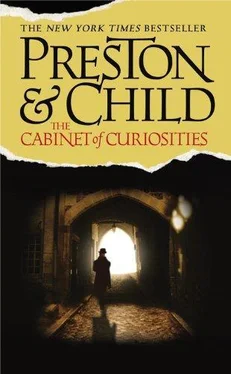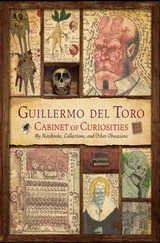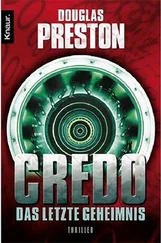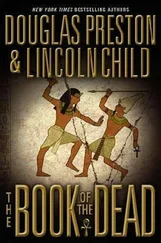Douglas Preston - The Cabinet of Curiosities
Здесь есть возможность читать онлайн «Douglas Preston - The Cabinet of Curiosities» весь текст электронной книги совершенно бесплатно (целиком полную версию без сокращений). В некоторых случаях можно слушать аудио, скачать через торрент в формате fb2 и присутствует краткое содержание. Жанр: Триллер, на английском языке. Описание произведения, (предисловие) а так же отзывы посетителей доступны на портале библиотеки ЛибКат.
- Название:The Cabinet of Curiosities
- Автор:
- Жанр:
- Год:неизвестен
- ISBN:нет данных
- Рейтинг книги:3 / 5. Голосов: 1
-
Избранное:Добавить в избранное
- Отзывы:
-
Ваша оценка:
- 60
- 1
- 2
- 3
- 4
- 5
The Cabinet of Curiosities: краткое содержание, описание и аннотация
Предлагаем к чтению аннотацию, описание, краткое содержание или предисловие (зависит от того, что написал сам автор книги «The Cabinet of Curiosities»). Если вы не нашли необходимую информацию о книге — напишите в комментариях, мы постараемся отыскать её.
The Cabinet of Curiosities — читать онлайн бесплатно полную книгу (весь текст) целиком
Ниже представлен текст книги, разбитый по страницам. Система сохранения места последней прочитанной страницы, позволяет с удобством читать онлайн бесплатно книгу «The Cabinet of Curiosities», без необходимости каждый раз заново искать на чём Вы остановились. Поставьте закладку, и сможете в любой момент перейти на страницу, на которой закончили чтение.
Интервал:
Закладка:
When he proposed to his editor the idea of a story on Leng, the man had grunted noncommittally — a sure sign he liked it. As he was leaving, he heard the bug-eyed monster mutter: “Just make damn sure it’s better than that Fairhaven piece, okay? Something with marrow. ”
Well, it would be better than Fairhaven. It had to be.
It was afternoon by the time he settled into the morgue. The librarian brought him the first of the volumes he’d requested, and he opened it with reverence, inhaling the smell of decaying wood pulp, old ink, mold, and dust. The volume was dated January 1881, and he quickly found the article he was looking for: the burning of Shottum’s cabinet. It was a front-page story, with a handsome engraving of the flames. The article mentioned that the eminent Professor John C. Shottum was missing and feared dead. Also missing, the article stated, was a man named Enoch Leng, who was vaguely billed as a boarder at the cabinet and Shottum’s “assistant.” Clearly, the writer knew nothing about Leng.
Smithback paged forward until he found a follow-up story on the fire, reporting that remains believed to be Shottum had been found. No mention was made of Leng.
Now working backward, Smithback paged through the city sections, looking for articles on the Museum, the Lyceum, or any mention of Leng, Shottum, or McFadden. It was slow going, and Smithback often found himself sidetracked by various fascinating, but unrelated, articles.
After a few hours, he began to get a little nervous. There were plenty of articles on the Museum, a few on the Lyceum, and even occasional mentions of Shottum and his colleague, Tinbury McFadden. But he could find nothing at all on Leng, except in the reports of the meetings of the Lyceum, where a “Prof. Enoch Leng” was occasionally listed among the attendees. Leng clearly kept a low profile.
This is going nowhere, fast, he thought.
He launched into a second line of attack, which promised to be much more difficult.
Starting in 1917, the date that Enoch Leng abandoned his Doyers Street laboratory, Smithback began paging forward, looking for any murders that fit the profile. There were 365 editions of the Times every year. In those days, murders were a rare enough occurrence to usually land on the front page, so Smithback confined himself to perusing the front pages — and the obituaries, looking for the announcement of Leng’s death which would interest O’Shaughnessy as well as himself.
There were many murders to read about, and a number of highly interesting obituaries, and Smithback found himself fascinated — too fascinated. It was slow going.
But then, in the September 10, 1918, edition, he came across a headline, just below the fold: Mutilated Body in Peck Slip Tenement. The article, in an old-fashioned attempt to preserve readers’ delicate sensibilities, did not go into detail about what the mutilations were, but it appeared to involve the lower back.
He read on, all his reporter’s instincts aroused once again. So Leng was still active, still killing, even after he abandoned his Doyers Street lab.
By the end of the day he had netted a half-dozen additional murders, about one every two years, that could be the work of Leng. There might have been others, undiscovered; or it might be that Leng had stopped hiding the bodies and was simply leaving them in tenements in widely scattered sections of the city. The victims were always homeless paupers. In only one case was the body even identified. They had all been sent to Potter’s Field for burial. As a result, nobody had remarked on the similarities. The police had never made the connection among them.
The last murder with Leng’s modus operandi seemed to occur in 1935. After that, there were plenty of murders, but none involving the “peculiar mutilations” that were Leng’s signature.
Smithback did a quick calculation: Leng appeared in New York in the 1870s — probably as a young man of, say, thirty. In 1935, he would have been about seventy. So why did the murders cease?
The answer was perfectly obvious: Leng had died. He hadn’t found an obituary; but then, Leng had kept such a low profile that an obituary would have been highly unlikely.
So much for Pendergast’s theory, thought Smithback.
And the more he thought about it, the more he felt sure that Pendergast couldn’t really believe such an absurd thing. No; Pendergast was throwing this out as a red herring for some devious purpose of his own. That was Pendergast through and through — artful, winding, oblique. You never knew what he was really thinking, or what his plan was. He would explain all this to O’Shaughnessy the next time he saw him; no doubt the cop would be relieved to hear Pendergast hadn’t gone off the deep end.
Smithback scanned another year’s worth of obituaries, but nothing on Leng appeared. Figures: the guy just cast no shadow at all on the historical record. It was almost creepy.
He checked his watch: quitting time. He’d been at it for ten straight hours.
But he was off to a good start. In one stroke, he’d uncovered another half-dozen unsolved murders which could likely be attributed to Leng. He had maybe two more days before his editor started demanding results. More, if he could show his work was turning up some nuggets of gold.
He eased himself out of the comfortable chair, rubbed his hands together. Now that he’d combed the public record, he was ready to take the next step: Leng’s private record.
One thing the day’s research had revealed was that Leng had been a guest researcher at the Museum. Smithback knew that, back then, all visiting scientists had to undergo an academic review in order to gain unfettered access to the collections. The review gave such details as the person’s age, education, degrees, fields of specialty, publications, marital status, and address. This might lead to other treasure troves of documents — deeds, leases, legal actions, so forth. Perhaps Leng could hide from the public eye — but the Museum’s records would be a different story.
By the time Smithback was done, he would know Leng like a brother.
The thought gave him a delicious shudder of anticipation.
FOUR
O’SHAUGHNESSY STOOD ON the steps outside the Jacob Javits Federal Building. The rain had stopped, and puddles lay here and there in the narrow streets of lower Manhattan. Pendergast had not been at the Dakota, and he was not here, at the Bureau. O’Shaughnessy felt an odd blend of emotions: impatience, curiosity, eagerness. He’d been almost disappointed that he couldn’t show his find to Pendergast right away. Pendergast would surely see the value of the discovery. Maybe it would be the clue they needed to break the case.
He ducked behind one of the building’s granite pillars to inspect the journals once again. His eye ran down the columned pages, the countless entries of faded blue ink. It had everything: names of purchasers, lists of chemicals, amounts, prices, delivery addresses, dates. Poisons were listed in red. Pendergast was going to love this. Of course, Leng would have made his purchases under a pseudonym, probably using a false address — but he would have had to use the same pseudonym for each purchase. Since Pendergast had already compiled a list of at least some of the rare chemicals Leng had used, it would be a simple matter to match that with the purchases in this book, and, through that, discover Leng’s pseudonym. If it was a name Leng used in other transactions, this little book was going to take them very far indeed.
O’Shaughnessy glanced at the volumes another minute, then tucked them back beneath his arm and began walking thoughtfully down Broadway, toward City Hall and the subway. The volumes covered the years 1917 through 1923, antedating the fire that burned the chemist’s shop. Clearly, they’d been the only things to survive the fire. They had been in the possession of the grandfather, and the father had had them rebound. That was why the antiques dealer hadn’t bothered to examine them: they looked modern. It had been sheer luck that he himself had—
Читать дальшеИнтервал:
Закладка:
Похожие книги на «The Cabinet of Curiosities»
Представляем Вашему вниманию похожие книги на «The Cabinet of Curiosities» списком для выбора. Мы отобрали схожую по названию и смыслу литературу в надежде предоставить читателям больше вариантов отыскать новые, интересные, ещё непрочитанные произведения.
Обсуждение, отзывы о книге «The Cabinet of Curiosities» и просто собственные мнения читателей. Оставьте ваши комментарии, напишите, что Вы думаете о произведении, его смысле или главных героях. Укажите что конкретно понравилось, а что нет, и почему Вы так считаете.










